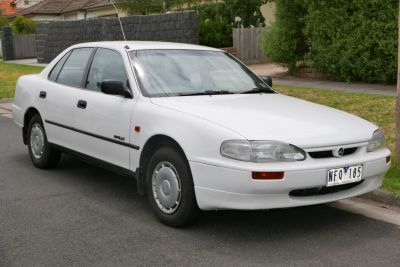 1992 Toyota Mark II (GX90) Dimensions, Size & Specs
1992 Toyota Mark II (GX90) Dimensions, Size & SpecsMeasurements of the 1992 Toyota Mark II, engineered for optimal performance and comfort
| Dimensions | |
|---|---|
| Length: | 4750 mm187.0 in15.6 ft |
| Width: | 1750 mm68.9 in5.7 ft |
| Height: | 1390 mm54.7 in4.6 ft |
| Weight Specifications | |
| Curb Weight: | 1250-1450 kg2756-3197 lbs |
| Maximal permitted Weight: | 1525-1725 kg3362-3803 lbs |
| Tire Specifications | |
| Rims Sizes: |
|
| Tire Sizes: |
|
The Toyota Mark II (GX90) is a mid-size sedan produced between 1992 and 1996, known for its balanced dimensions and reliable engineering. Measuring 4750 mm (187 inches) in length, 1750 mm (69 inches) in width, and 1390 mm (55 inches) in height, the GX90 offers a spacious yet streamlined profile ideal for both urban and highway driving. Curb weight varies from 1250 to 1450 kg (2755 to 3196 lbs), depending on trim levels and options, while the maximum gross weight ranges between 1525 and 1725 kg (3362 to 3802 lbs), reflecting its capability to accommodate passengers and cargo comfortably. The Mark II GX90 supports a range of rim sizes including 15 and 16 inches, paired with various tire sizes such as 185/70 R14 S, 195/65 R15, and 225/50 R16, enabling drivers to choose setups for enhanced performance or comfort. This generation of the Mark II continues Toyota's heritage of delivering durable sedans with a mix of practicality and driving refinement. Its size places it competitively within the mid-size sedan class of the early 1990s, appealing to drivers seeking a reliable and moderately sized vehicle. In summary, the Toyota Mark II (GX90) balances practical dimensions and weight with flexible tire options, making it a noteworthy choice among sedans of its era.
Discover the standout features that make the 1992 Toyota Mark II a leader in its class
Have a question? Please check our knowledgebase first.
The Toyota Mark II (GX90) produced from 1992 to 1996 has an overall length of 4750 mm (approximately 187 inches or 15.6 feet), a width of 1750 mm (about 69 inches or 5.75 feet), and a height of 1390 mm (roughly 54.7 inches or 4.56 feet). These dimensions make it a mid-sized sedan by Japanese standards of the era, designed to balance road presence with maneuverability and comfortable cabin space.
The curb weight of the Toyota Mark II (GX90) varies between approximately 1250 kg and 1450 kg (about 2755 to 3196 pounds). Its maximum permissible weight ranges from 1525 kg to 1725 kg (around 3362 to 3804 pounds). This weight range reflects different trims and optional equipment setups. The moderate weight contributes to a stable yet agile driving experience, offering a balance between good handling and comfortable ride quality typical of mid-1990s sedans.
With a length of 4750 mm (15.6 feet) and a width of 1750 mm (5.75 feet), the Toyota Mark II (GX90) fits comfortably within most standard Single-car garages, which typically have dimensions starting around 6 meters (20 feet) in length and 3 meters (10 feet) wide. However, owners should consider additional space needed for opening doors and walking around the vehicle. Its moderate height of 1390 mm (4.56 feet) poses no issues for garage clearance, making it practical for typical residential parking.
The Toyota Mark II (GX90) supports a variety of rim sizes including 14, 15, and 16 inches, with matching tire sizes such as 185/70 R14, 195/65 R15, 205/60 R15, 205/55 R16, 225/50 R16, among others. Smaller tires like the 14-inch setups offer a softer ride due to taller sidewalls, enhancing comfort on rough surfaces, while the 16-inch sizes with lower profile tires provide better handling and road grip but a firmer ride. This versatility allowed drivers to prioritize comfort or sportiness according to preference.
At 1390 mm (54.7 inches), the GX90 Toyota Mark II is relatively low-profile compared to many contemporaneous sedans, which often ranged from about 1400 to 1500 mm in height (55 to 59 inches). This relatively low height enhances aerodynamic efficiency and contributes to a sporty look, while also lowering the center of gravity for better handling dynamics. The lower stance is a design characteristic that appealed to buyers seeking a blend of luxury and sportiness.
Compared to the GX80 generation, which was produced until the early 1990s, the GX90 Mark II generally grew in dimensions. The GX90 length is about 4750 mm, slightly longer than the GX80 which measured closer to 4600-4700 mm. The width of 1750 mm remained similar or slightly wider, providing improved interior space and road presence. Overall, the GX90 offered a more refined and slightly larger body that enhanced passenger comfort and cargo capacity, representing a natural evolution in size to meet market expectations.
In the mid-1990s, the Toyota Mark II (GX90) was competitive in size against rivals such as the Nissan Leopard and the Honda Accord. The Mark II's length of 4750 mm (187 inches) was generally on par or slightly longer than the Honda Accord (about 4700 mm) but comparable with the sportier Nissan Leopard. Its width of 1750 mm was average among mid-size sedans, slightly narrower than some American counterparts but appropriate for the Japanese market. Its relatively low height gave the GX90 a sporty silhouette, distinguishing it within its class for buyers valuing a balance between executive appeal and dynamic styling.
The Toyota Mark II (GX90) can support a maximum weight ranging from 1525 kg to 1725 kg (approximately 3362 to 3804 pounds), depending on the trim and configuration. This maximum weight includes the vehicle's curb weight plus passengers, cargo, and any additional load. Understanding this limit is important to avoid overloading, which can negatively affect safety, handling, braking, and tire wear. Given the curb weight range of about 1250 to 1450 kg, this allows for a payload (passenger plus cargo) capacity roughly between 275 kg and 475 kg, accommodating typical family and luggage needs.
The Toyota Mark II (GX90) is compatible with rims sized 14, 15, and 16 inches, supporting various tire sizes such as 185/70 R14, 195/65 R15, 205/60 R15, 205/55 R16, and 225/50 R16. The tire width and profile typically impact handling, road grip, and ride comfort. Larger rims (16-inch) with lower-profile tires enhance cornering and handling precision but may result in a firmer ride. Smaller rims with higher-profile tires contribute to more comfort and better shock absorption on uneven roads. This flexibility allowed owners to customize the driving experience to preference or road conditions.
Curb weight for the Toyota Mark II (GX90) ranges from approximately 1250 kg to 1450 kg (2755 to 3196 pounds) depending on the trim, engine options, and added equipment. Heavier trims tend to feature more luxury or performance features, which can slightly reduce fuel economy due to increased mass. Buyers should expect moderate fuel efficiency typical of mid-1990s sedans powered by inline-six or four-cylinder engines, with variations depending on engine displacement and driving conditions. Overall, it balances performance and economy consistent with Japanese executive sedans of its time.
Discover similar sized cars.

| Production: | 1955-1962 |
|---|---|
| Model Year: | 1955 |
| Length: | 4800 mm189.0 in |
| Width: | 1790 mm70.5 in |
| Height: | 1470 mm57.9 in |

| Production: | 1957-1962 |
|---|---|
| Model Year: | 1957 |
| Length: | 4800 mm189.0 in |
| Width: | 1790 mm70.5 in |
| Height: | 1470 mm57.9 in |

| Production: | 1989-1991 |
|---|---|
| Model Year: | 1989 |
| Length: | 4690 mm184.6 in |
| Width: | 1695 mm66.7 in |
| Height: | 1355 mm53.3 in |

| Production: | 1990-1994 |
|---|---|
| Model Year: | 1990 |
| Length: | 4790 mm188.6 in |
| Width: | 1777 mm70.0 in |
| Height: | 1431-1437 mm56.3-56.6 in |

| Production: | 1991-1996 |
|---|---|
| Model Year: | 1991 |
| Length: | 4725 mm186.0 in |
| Width: | 1770 mm69.7 in |
| Height: | 1420 mm55.9 in |

| Production: | 1991-1996 |
|---|---|
| Model Year: | 1991 |
| Length: | 4725 mm186.0 in |
| Width: | 1770 mm69.7 in |
| Height: | 1400 mm55.1 in |

| Production: | 1992-1996 |
|---|---|
| Model Year: | 1992 |
| Length: | 4750 mm187.0 in |
| Width: | 1750 mm68.9 in |
| Height: | 1390 mm54.7 in |

| Production: | 1992-1996 |
|---|---|
| Model Year: | 1992 |
| Length: | 4750 mm187.0 in |
| Width: | 1750 mm68.9 in |
| Height: | 1390 mm54.7 in |
